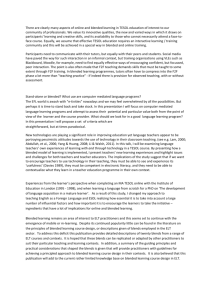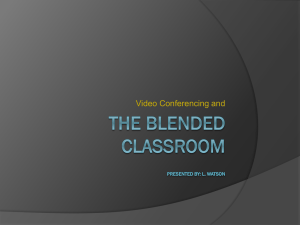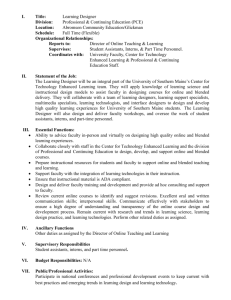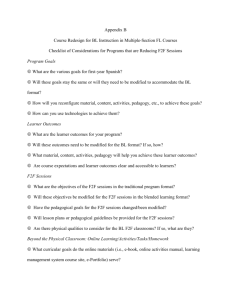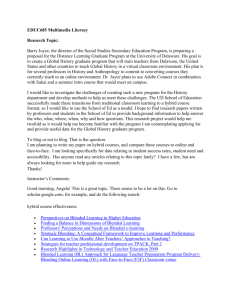Designing Blended Learning to Engage Learners Online and In
advertisement
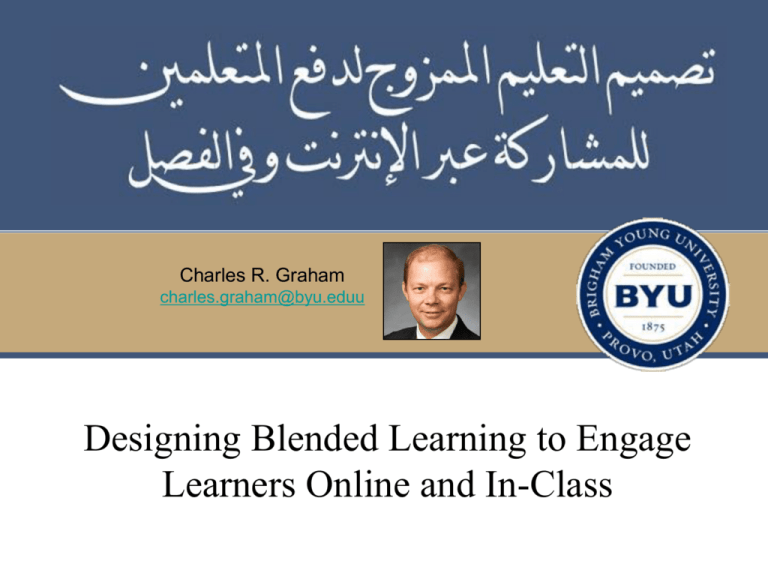
Charles R. Graham charles.graham@byu.eduu Designing Blended Learning to Engage Learners Online and In-Class Overview 1. Brief Introductions 2. What is Blended Learning? 3. What do learners think about blended learning? 4. What does effective BL look like? 2 Family and Research BL articles available at: http://bit.ly/BL-research 3 Getting to know you What discipline areas do you teach in? • • • • Sciences Education Social Sciences Engineering • • • • Fine Arts Business Law Humanities 4 Getting to know you Have you taught an online or blended learning course before? 5 Blended Learning Resources Books and research articles on Blended Learning – http://bit.ly/BL-resources BL Research Articles – http://bit.ly/BL-research BL Presentations – http://bit.ly/BL-presentations BL Institutional Adoption Checklist – http://bit.ly/BL-adopt-checklist BL Video Examples – http://bit.ly/BL-video-examples 6 What is Blended Learning? 7 Definition Definition: Blended learning combines face-to-face instruction with computer-mediated (online) instruction. 8 Blended Learning Spectrum Traditional F2F (no online components) Technology Enhanced (no reduction in F2F contact time) Blended Learning (reduction in F2F contact time) Mostly Online (supplemental or optional F2F contact) Completely Online (no F2F components) 9 Blended Learning Spectrum Sometimes institutions call these blended but often they are not considered to be blended Traditional F2F (no online components) Technology Enhanced (no reduction in F2F contact time) Blended Learning (reduction in F2F contact time) Mostly Online (supplemental or optional F2F contact) Completely Online (no F2F components) Image Source: Graham, C. R., Woodfield, W., & Harrison, J. B. (2013). A framework for institutional adoption and implementation of blended learning in higher education. The Internet and Higher Education, 18(3), 4–14. doi:10.1016/j.iheduc.2012.09.003 http://bit.ly/BL-research 10 Blended Learning Spectrum Sometimes institutions call these blended but often they are not considered to be blended Traditional F2F (no online components) Technology Enhanced (no reduction in F2F contact time) Blended Learning (reduction in F2F contact time) Mostly Online (supplemental or optional F2F contact) Completely Online (no F2F components) Because of the supervisory responsibility in K-12 . . . often the online portions are done in the brick and mortar school. 11 What do learners think about blended learning? 12 Learner Preferences ECAR 2011 - Responses from 3,000 students at 1,179 colleges and universities provided a nationally representative sample of students. Source: http://www.educause.edu/library/resources/ecar-nationalstudy-undergraduate-students-and-information-technology-2011-report ECAR 2012 -195 institutions; 106,575 student responses, stratified sample of 10,000 U.S.-based respondents to proportionally match IPEDS undergraduate demographics. Source: http://www.educause.edu/library/resources/ecar-studyundergraduate-students-and-information-technology-2012 13 2011 ECAR survey Source: http://www.educause.edu/library/resources/ecar-national-study-undergraduate-students-and-information-technology-2011-report 14 2012 ECAR survey Source: http://www.educause.edu/library/resources/ecar-study-undergraduate-students-and-information-technology-2012 15 2012 ECAR survey Engagement Winners Source: http://www.educause.edu/library/resources/ecar-study-undergraduate-students-and-information-technology-2012 16 What does research say about the effectiveness of BL? Summary at: Graham, C. R. (2013). Emerging practice and research in blended learning. In M. G. Moore (Ed.), Handbook of distance education (3rd ed., pp. 333–350). New York, NY: Routledge. http://bit.ly/BL-research 17 Effectiveness Research Barbara Means meta analysis: • 45 very different blends • Improved outcomes for blended learning • Couldn’t identify reason for improvement 18 Effectiveness Research Current BL Research Cases (2014) Global Examples of BL in practice Includes literature review on BL focusing on learning effectiveness, student and faculty satisfaction, access, and cost effectiveness. 19 What does effective BL look like? 20 Which item doesn’t belong? 21 Technology itself is not bad or good … technology = tool value = how you use it 22 What makes a learning experience engaging? 23 Think of interaction with . . . . . . peers and instructors . . . Content Student How is the student engaging inside and outside of class? 24 Purpose of BL . . . . . . is NOT to eliminate the human interaction . . . IS to maximize the potential of the learner-human and the learner-content interaction. 25 What are some of the challenges that prevent EVERY LEARNER from engaging in your 26 Challenges to Engagement (Six Ps) Personal Interaction Pacing Preparation Participation (active learning) Personalization Place (Authenticity) 27 Learner preparation through online quizzes Online quizzes – flipping classroom – Accounting (watch) 28 Flipping classroom for more active learning Mastery & Personalizing - Video Link Problem solving in class - Video Link Personal Interaction for struggling students Student Perspectives - Video Link 29 Have you had an experience like this . . . Bethany & Math Homework 30 Blended Math Instruction – K-12 Student - Video Link Teacher - Video Link 31 Math Emporium – Higher Ed Video Link 32 Differing Ability Levels Each student's ability to understand and apply the material varies. The more students in a class, the more difficult it becomes to scaffold individual student learning. Pre-class self-paced instruction with feedback – Chem Tutor (watch video)(link to Chem Tutor)(example module with practice/feedback) 33 Differing Ability Levels Differentiating - Video Link 34 Authenticity + Access Because instruction is confined to a specific space and time, authentic learning activities and assessments can be difficult to design for the classroom. Simulated environments can provide access learning experiences that are more authentic than lecturebased instruction. Above: BYU’s Virtual ChemLab (link to video) Above: BYU’s Virtual Audiometer (link to video) (link to CTL demo) 35 Personal Interaction Even in smaller traditional classes, it can be difficult for the instructor to set aside time for personal one-on-one interaction and feedback with students. Personalized Video Feedback - Animation Class (watch) 36 Participation – online discussions Time constraints in a physical classroom may make it difficult for everyone to participate or contribute to a discussion. 37 Pacing Especially in larger traditional classes, it is often difficult to match your instructional pace with your individual students' ability to learn the material. Student self-pacing – Intro to Accounting (watch) 38 Scheduling Collaboration Effective collaboration can be a catalyst for learning in a course. Sometimes instructors avoid collaboration because it is difficult to manage this when schedules conflict. Group Feedback - Psychology Class (watch) 39 Challenge 1. Help learners to be more active (both face-to-face and online). 2. Be creative – do what works for you and the students. Passive Transmission oriented Active learning 40 We need to figure out how Future learning systems may not be differentiated as much based on whether they blend but rather by how they blend. Ross, B., & Gage, K. (2006). Global perspectives on blended learning. In C. J. Bonk & C. R. Graham (Eds.), Handbook of blended learning: Global perspectives, local designs (pp. 155-168). San Francisco, CA: Pfeiffer Publishing. 41 Questions? 42 Blended Learning Resources Books and research articles on Blended Learning – http://bit.ly/BL-resources BL Research Articles – http://bit.ly/BL-research BL Presentations – http://bit.ly/BL-presentations BL Institutional Adoption Checklist – http://bit.ly/BL-adopt-checklist BL Video Examples – http://bit.ly/BL-video-examples 43


